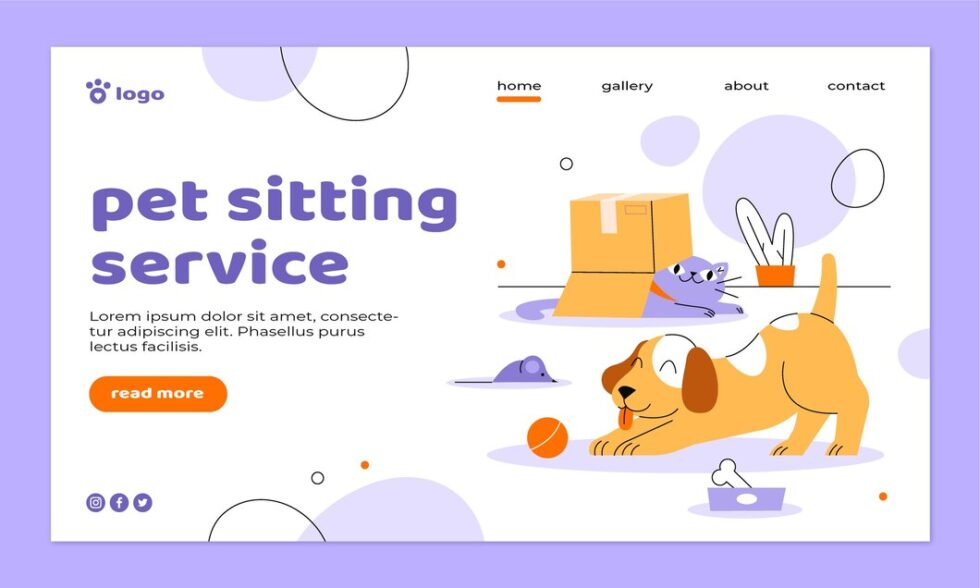Introduction to Pet Supplies Website Development
The pet industry is booming, and if you’re in the business of selling pet supplies, having an online presence is no longer optional—it’s essential. A well-developed pet supplies website can be a game-changer, helping you reach a broader audience, increase sales, and build a loyal customer base. But where do you start? This article will guide you through the essential steps of creating a successful pet supplies website, from planning and design to development, SEO optimization, and ongoing maintenance.
What is a Pet Supplies Website?
A pet supplies website is an online platform where pet owners can browse, purchase, and learn about various pet products, from food and toys to grooming supplies and accessories. These websites often feature e-commerce capabilities, allowing users to make purchases directly online, as well as informational content to help customers make informed decisions.
Importance of a Pet Supplies Website for Your Business
Expanding Your Market Reach
In today’s digital age, having a brick-and-mortar store is not enough. A website allows you to reach customers beyond your local area, tapping into a global market. Whether you’re selling specialized pet products or general supplies, a well-optimized website ensures that potential customers can find you with a simple online search.
Enhancing Customer Experience
A website provides a convenient shopping experience for your customers. They can browse products at any time, read reviews, compare prices, and make purchases from the comfort of their homes. Moreover, a well-designed website with clear navigation and helpful content can significantly enhance the user experience, leading to higher customer satisfaction and loyalty.
Key Features of a Successful Pet Supplies Website
Creating a successful pet supplies website involves more than just listing products online. It requires careful planning, design, and development to ensure the site meets the needs of both the business and its customers. Key features include a user-friendly design, e-commerce functionality, secure payment options, and search engine optimization (SEO) to drive traffic.
Planning Your Pet Supplies Website
Before diving into the design and development of your website, it’s crucial to plan thoroughly. This planning phase involves understanding your target audience, setting clear objectives, and budgeting for the project.
Understanding Your Target Audience
Identifying Your Niche
The pet supplies industry is vast, with products ranging from basic essentials to luxury items. Identifying your niche—whether it’s organic pet food, eco-friendly toys, or premium grooming products—will help you tailor your website to attract the right audience.
Customer Demographics
Understanding who your customers are is key to creating a website that resonates with them. Consider factors like age, location, income level, and pet ownership habits. This information will guide your design, content, and marketing strategies.
Setting Clear Objectives for Your Website
Sales Goals
Determine what you want to achieve with your website. Is your primary goal to increase sales, or are you also looking to build brand awareness and engage with customers? Clear objectives will help you measure the success of your website.
Customer Engagement Goals
In addition to driving sales, your website can serve as a platform to engage with customers. Consider features like blogs, forums, or live chat options to interact with your audience and build a community around your brand.
Budgeting for Website Development
Website development can be costly, so it’s important to budget carefully. Consider the costs of design, development, content creation, SEO, and ongoing maintenance. Allocate funds for both the initial setup and future updates to keep your site running smoothly.
Designing Your Pet Supplies Website
The design of your website plays a crucial role in attracting and retaining customers. A well-designed site should be visually appealing, easy to navigate, and responsive on all devices.
User-Friendly Design
Easy Navigation
Your website’s navigation should be intuitive, allowing users to find what they’re looking for with minimal effort. Consider organizing your products into clear categories and using a search function to help users locate specific items.
Mobile Responsiveness
With more people shopping on their phones, having a mobile-responsive website is essential. Ensure that your site looks and functions well on all devices, from desktops to smartphones.
Visual Appeal
Color Scheme and Branding
Your website’s color scheme should reflect your brand and appeal to your target audience. Use colors that evoke the right emotions and are consistent with your logo and other branding elements.
High-Quality Images
High-quality images are vital for showcasing your products. Invest in professional photography to highlight the details and benefits of your products, and use images that are consistent in style and quality across your site.
Essential Pages to Include
Home Page
Your home page is the first impression visitors will have of your website. It should clearly communicate who you are, what you offer, and how customers can benefit from your products.
Product Pages
Each product should have its own page with detailed descriptions, pricing information, and high-quality images. Include customer reviews and ratings to build trust and help customers make informed decisions.
About Us Page
The About Us page is an opportunity to tell your brand’s story and connect with your audience. Share your mission, values, and the inspiration behind your business.
Contact Us Page
Make it easy for customers to get in touch with you. Include a contact form, phone number, email address, and physical address if applicable. Consider adding a live chat feature for instant customer support.
Blog Page
A blog is a great way to engage with your audience, share useful information, and improve your website’s SEO. Regularly updated content can drive traffic to your site and establish your brand as an authority in the pet industry.
Developing Your Pet Supplies Website
With the design in place, it’s time to develop your website. This phase involves choosing the right platform, integrating e-commerce functionality, and ensuring security. Pet Supplies Website Development.
Choosing the Right Platform
Shopify
Shopify is a popular choice for e-commerce websites, offering a range of customizable templates and built-in features. It’s user-friendly, making it a great option for those without extensive technical knowledge.
WooCommerce
WooCommerce is a WordPress plugin that allows you to add e-commerce functionality to your existing WordPress site. It’s highly customizable, but may require more technical expertise than Shopify.
Custom Solutions
If you have specific needs that off-the-shelf platforms can’t meet, consider a custom-built website. This option offers complete flexibility but can be more expensive and time-consuming to develop.
Integrating E-commerce Functionality
Shopping Cart and Checkout Process
A seamless shopping cart and checkout process are crucial for converting visitors into customers. Ensure that the process is straightforward, with minimal steps, and offers multiple payment options.
Payment Gateway Integration
Integrate secure payment gateways like PayPal, Stripe, or Square to provide customers with safe and convenient payment options. Consider offering multiple payment methods to cater to different customer preferences.
Ensuring Security and Compliance
SSL Certificates
An SSL certificate is essential for protecting your customers’ data and ensuring secure transactions. It also boosts your website’s credibility and can improve your search engine rankings.
Data Protection Regulations
Compliance with data protection regulations, such as GDPR in Europe or CCPA in California, is crucial for avoiding legal issues. Ensure that your website has a clear privacy policy and obtains proper consent for data collection.
Optimizing Your Pet Supplies Website for SEO
Search engine optimization (SEO) is key to driving organic traffic to your website. By optimizing your site for relevant keywords, you can improve your search engine rankings and attract more visitors.
Keyword Research for the Pet Industry
Long-Tail Keywords
Long-tail keywords are specific phrases that customers are likely to search for, such as “organic dog food for small breeds.” These keywords may have lower search volumes but tend to have higher conversion rates.
Competitor Analysis
Analyze your competitors to identify which keywords they’re targeting and which strategies they’re using to rank highly in search engine results. Use this information to refine your own SEO strategy.
On-Page SEO Best Practices
Meta Tags and Descriptions
Ensure that each page of your website has unique meta tags and descriptions that include relevant keywords. This helps search engines understand the content of your pages and improves your chances of ranking well.
Content Optimization
Optimize your content for both search engines and users. Use keywords naturally in your headings, subheadings, and body text, and ensure that your content is informative, engaging, and easy to read.
Off-Page SEO Strategies
Backlink Building
Backlinks—links from other websites to yours—are a key factor in SEO. Focus on building high-quality backlinks from reputable sites in the pet industry to improve your search engine rankings.
Social Media Integration
Social media can drive traffic to your website and improve your SEO. Share your content on platforms like Facebook, Instagram, and Pinterest, and encourage your followers to link back to your site.
Content Creation for Your Pet Supplies Website
Content is king when it comes to attracting and retaining customers. From product descriptions to blog posts, the content on your website should be informative, engaging, and tailored to your audience.
Product Descriptions
Highlighting Features and Benefits
Your product descriptions should go beyond listing features. Highlight the benefits of each product and explain how it can solve a problem or improve the life of the pet or pet owner.
Using Persuasive Language
Use persuasive language to encourage customers to make a purchase. Focus on the unique selling points of your products and use action-oriented words to inspire confidence and urgency. Pet Supplies Website Development.
Blogging for SEO and Engagement
Pet Care Tips
Blogging about pet care tips is a great way to provide value to your audience while improving your SEO. Topics like “How to Choose the Right Food for Your Dog” or “The Benefits of Regular Grooming” can attract readers and establish your brand as an authority.
Product Reviews
Product reviews can help customers make informed decisions and build trust in your brand. Consider writing reviews of popular pet products, comparing different options, or featuring customer testimonials.
Visual Content
Videos and Tutorials
Videos are a powerful tool for engaging your audience. Consider creating tutorials on how to use your products, or behind-the-scenes videos showing how your products are made.
Infographics
Infographics are an effective way to present complex information in an easy-to-understand format. Use them to share pet care tips, statistics, or comparisons of different products.
Marketing Your Pet Supplies Website
Once your website is live, it’s time to attract visitors through marketing. A mix of email marketing, social media, and paid advertising can help you reach your target audience.
Email Marketing Campaigns
Building a Subscriber List
Start by building a subscriber list through your website. Offer incentives like discounts or free guides to encourage visitors to sign up for your email list.
Crafting Engaging Newsletters
Send regular newsletters with updates on new products, special offers, and useful pet care tips. Make sure your emails are visually appealing and provide value to your subscribers.
Social Media Marketing
Platforms to Focus On
Choose social media platforms that align with your target audience. For example, Instagram is great for visual content, while Facebook is ideal for community-building and customer engagement.
Content Strategies
Develop a content strategy that includes a mix of promotional posts, educational content, and engaging visuals. Encourage user-generated content by asking customers to share photos of their pets using your products.
Paid Advertising
Google Ads
Google Ads can help you reach customers who are actively searching for pet products. Use targeted keywords and create compelling ad copy to drive traffic to your website.
Social Media Ads
Social media ads on platforms like Facebook and Instagram allow you to target specific demographics and interests. Experiment with different ad formats, such as carousel ads or video ads, to see what works best for your audience.
Maintaining and Updating Your Pet Supplies Website
A website is never truly finished. Regular maintenance and updates are essential to keep your site running smoothly and meeting the needs of your customers.
Regular Content Updates
Keeping Product Listings Fresh
Ensure that your product listings are always up-to-date with accurate descriptions, prices, and availability. Remove any discontinued items and add new products as they become available. Pet Supplies Website Development
Blogging Consistently
Consistent blogging helps keep your website active and engaging. Aim to publish new blog posts regularly to maintain your audience’s interest and improve your SEO.
Monitoring Website Performance
Analytics Tools
Use analytics tools like Google Analytics to monitor your website’s performance. Track metrics like traffic, bounce rates, and conversion rates to identify areas for improvement. Pet Supplies Website Development.
User Feedback
Collect feedback from your customers to understand their needs and preferences. Use this information to make adjustments to your website and improve the user experience.
Security Updates and Backups
Keep your website secure by regularly updating your software and plugins. Perform regular backups to ensure that you can quickly restore your site in case of any issues.
Conclusion
Developing a pet supplies website is a multifaceted process that requires careful planning, design, development, and ongoing maintenance. By understanding your target audience, setting clear objectives, and optimizing your site for SEO, you can create a successful online platform that drives sales and engages customers. Remember, a website is a living entity that needs regular updates and care to thrive in the competitive pet industry.
FAQs
How much does it cost to develop a pet supplies website?
The cost of developing a pet supplies website can vary widely depending on factors like design complexity, e-commerce functionality, and customization. On average, you can expect to spend anywhere from $5,000 to $50,000.
What platform is best for a pet supplies website?
The best platform depends on your specific needs. Shopify is user-friendly and ideal for beginners, while WooCommerce offers more customization options for those familiar with WordPress. Custom-built solutions offer maximum flexibility but can be more expensive.
How can I improve the SEO of my pet supplies website?
To improve your website’s SEO, focus on keyword research, on-page optimization (like meta tags and content), and off-page strategies like backlink building. Regularly update your content and consider blogging to attract more traffic. Pet Supplies Website Development
How often should I update my pet supplies website?
Your website should be updated regularly to keep content fresh and relevant. This includes updating product listings, adding new blog posts, and ensuring all software and security measures are up to date.
Can I integrate a blog into my pet supplies website?
Yes, integrating a blog into your pet supplies website is highly recommended. A blog can improve your SEO, engage customers, and establish your brand as an authority in the pet industry. Pet Supplies Website Development



